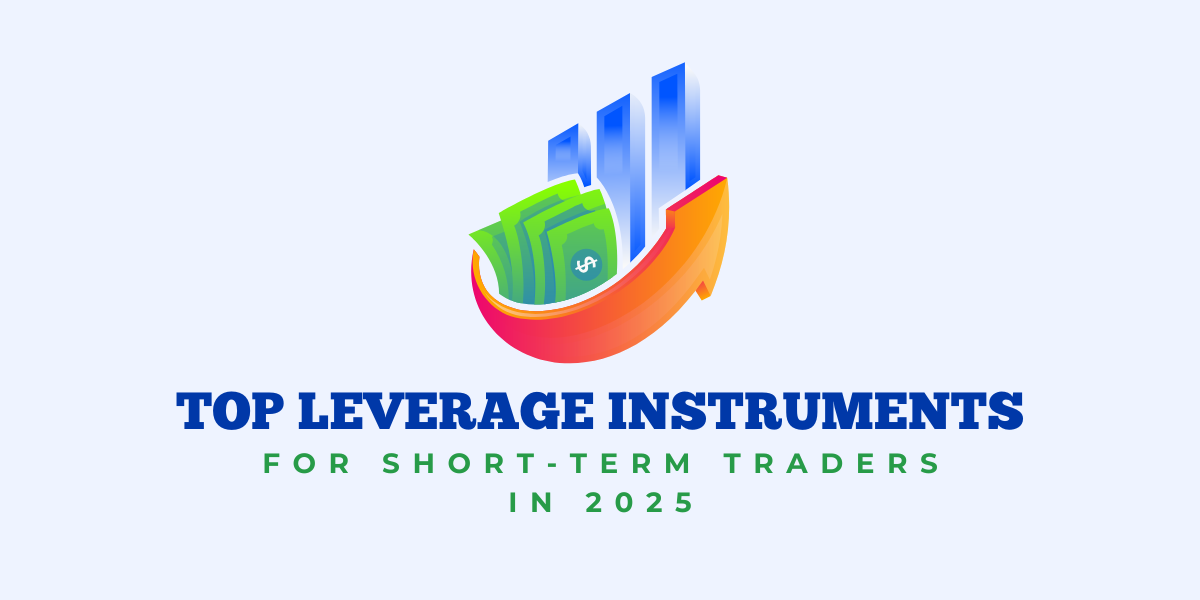Stocks swing five percent in a morning, Bitcoin launches weekend moonshots, and rate headlines crash bond futures before breakfast. In 2025, short-term traders can’t ignore leverage; it’s the only way a modest account can keep pace with giant daily moves.
But you no longer need a wall of different products to play the game. Master just a handful, understand their quirks in depth, and you’re equipped for whatever the market throws at you.

Let’s get right into it.
CFDs at Forex Brokers: The All-Purpose Leveraged Bet
Although banned in the United States, Contracts for Difference remain the backbone of speculative trading platforms from London to Singapore.
For retail traders outside the U.S., the simplest way to access them is to trade CFDs at Forex brokers, where these instruments are bundled alongside currency pairs, indices, and even crypto.
A CFD is a pure price wager: you never own underlying shares, oil barrels, or gold bars; you simply capture the difference between your entry and exit prices.
Before diving into the details, note one remarkable fact: while detailed volume breakdowns aren’t publicly disclosed, CFDs remain a cornerstone of Europe’s retail leveraged trading under ESMA/FCA oversight, operating with maximum leverage caps of 30:1 on major FX pairs, 20:1 on indices, and 5:1 on single-stock CFDs.
What Makes CFDs So Flexible?
CFDs offer granular position sizing, open a 50 micro−lot in EUR/USD, a 20 slice of the S&P 500, or a $5 micro-Bitcoin contract.
Built-in leverage is the second hook. Inside ESMA jurisdictions, caps sit at 30:1 for major FX pairs, 20:1 for index CFDs, and 5:1 for single stocks.
Outside Europe, you’ll still find brokers dangling 100:1 on FX and 50:1 on stock indices, but always verify local regs before salivating over numbers.
Equally important is the ability to flip from long to short instantly. No stock-borrow hassle, no crypto lending desk, click “Sell” and you’re short. Around-the-clock price feeds on FX, indices, and many crypto pairs fill the gap when equities sleep, but geopolitics doesn’t.
Cost Structure, Hidden and Visible
Most brokers either widen the spread or tack on a per-trade commission; occasionally, they do both. The big invisible fee is overnight financing, known as the “swap.”
Hold a Nasdaq CFD for more than a day and you pay (or receive) an interest rate tied to interbank benchmarks plus broker markup. If you plan multi-day holds, shop those swap rates first differences can turn a promising swing trade into an uphill slog.
Dividend adjustments trip up newcomers as well. Go short an index CFD the evening before several constituents announce ex-dividends, and you’ll see cash debited from your account even if the price chart looks flat.
Risk Quirks in 2025
Thanks to new U.K. rules, negative-balance protection is automatic under FCA oversight, but it isn’t guaranteed everywhere. Confirm it in writing. Platform reliability is another soft spot.
MetaTrader 4/5 still rules, yet outages last year during U.S. CPI releases froze positions for minutes that felt like hours. If you use high leverage, pick a secondary login (cTrader, TradingView bridge, or web-terminal) for emergency exits.
Finally, dealer risk matters. Your counterparty is usually the broker’s liquidity pool, not an exchange. Tier-one auditors, segregated client funds, and published execution statistics are your only real defenses.
Zero-Day and Weekly Options: Intraday Volatility on Demand
Daily expiring S&P 500 options (0DTE) launched in 2022; by 2025, they’re available on Nasdaq-100, Russell 2000, and headline magnet stocks like NVDA or TSLA.
Volume exploded for one simple reason: traders crave defined cost with uncapped upside. By May 2025, 0DTE SPX options surged to over 61% of total S&P 500 option volume, averaging more than 2.1 million contracts daily while retail traders drove roughly 54% of that volume.
Mechanics You Must Respect
Invest in a 0DTE call at 2.00, with a maximum loss of 200 per contract, but keep in mind that the Greeks can move quickly. Gamma is massive because there’s no time left; delta can surge from 0.10 to 0.90 in minutes if price races toward the strike.
Conversely, time decay (theta) devours out-of-the-money positions almost immediately after the open. You can’t buy and forget a watch or set conditional exits.
Brokers now provide micro-contracts (5 multiples on SPY and QQQ), so smaller accounts can build multi-leg spreads cheaply. That means you can construct an iron butterfly for under $150 in total risk rather than the old $500-plus ticket.
Tactical Patterns That Still Work
Earnings plays remain the crowd favorite. Traders buy cheap morning-of options on the theory that a one-day surge or crash will outpace premium decay.
Back-testing on the top 50 market-cap names shows only 18% of pre-earnings straddles remained profitable through the close on announcement day, yet successful ones often returned 200% or more, underscoring that win rate isn’t everything; payoff distribution matters.
Gamma scalping is another niche strategy. Open an at-the-money straddle, then hedge delta with micro E-mini futures every ten ticks. Each rebalance harvests gamma while you bleed theta.
If volatility stays wild, you net out positive; if it doesn’t, you bleed. Execution speed is crucial: measured latency to the CME engine should be under 80 ms for serious scalpers.
Bottom-Line Risks
Pattern-day-trader rules still apply in the U.S., and cash-settled options close out the same day.
Miss the cutoff and you’re flagged for “good-faith violations.”

Crypto Perpetual Swaps: Leverage Without Weekends Off
Perpetual swaps let traders crank leverage on Bitcoin, Ether, and a laundry list of altcoins without dealing with expiry dates. Funding fees, exchanged every eight hours, keep perp pricing glued to spot.
Innovation keeps accelerating. Decentralized exchanges (dYdX, Vertex) now match orders on-chain, sidestepping FTX-style custody nightmares. Binance and OKX answer by launching “portfolio margin” sub-accounts that net long and short perps, spot, and options, reducing collateral strain.
Reality Checks on Leverage
Platforms flaunt 125× leverage, yet smart traders rarely exceed 10×. Why? Liquidation engines can sell you out if the price moves less than one percent against a 100× position.
On-chain perps add oracles to the hazard list; if blockchain congestion delays price updates, you can be liquidated on stale prints. Use an isolated margin while you’re learning. Once comfortable, migrate to cross-margin portfolios where hedged positions share collateral.
Funding Fees and Calendar Arbitrage
Funding flips positive or negative depending on market imbalance. When longs dominate, they pay shorts; when shorts crowd in, the reverse happens.
Savvy traders faded the basis by shorting perps and buying spot, pocketing the funding. That edge has narrowed as AI models predict funding spikes and exchanges cap extremes, but opportunities still surface after big news.
The 2025 Risk and Execution Playbook
Leverage is indifferent to your ego. Before opening a position, create mechanical guardrails so human emotions can’t hijack the plan.
Hard Caps and Soft Triggers
Setting a maximum daily loss of 2% of equity is common, and program your platform to lock trading for the rest of the session if breached. Layer in “soft triggers,” such as pausing after three consecutive losing trades, to prevent tilt.
Latency and Redundancy
If your strategy hinges on intraday price spikes, measure platform latency. Anything above 100 ms round-trip can turn a profitable scalping model into a random walk. Maintain a secondary device, tablet, or phone with a separate internet link in case your primary line fails during a volatility burst.
Tax and Record Keeping
High-velocity trading produces thousands of taxable events. Export trade logs weekly into a reconciliation spreadsheet or third-party tracker. Waiting until April 14 is an account-closing mistake.
Conclusion: Fewer Leverage Instruments, Deeper Mastery
You don’t need every leveraged product under the sun; you need one you truly understand, plus a backup. CFDs suit traders who want global markets and micro-lot sizing.
Zero-day options attract adrenaline junkies who can watch the tape all session. Crypto perps reward those who crave 24/7 action and trust self-custody.
Pick your weapon, drill its mechanics until they’re instinctive, and enforce risk limits like seat belts. Leverage magnifies skill; unfortunately, it magnifies ignorance faster. Make sure you’re on the right side of that equation in 2025.


 Tags:
Tags:










